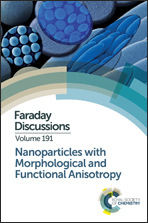Novel stabilisation of emulsions by soft particles: polyelectrolyte complexes†
Abstract
We put forward the concept of a novel particle stabiliser of oil–water emulsions, being the polyelectrolyte complex (PEC) formed between oppositely charged water-soluble polymers in cases where either polymer alone is incapable of stabilising an emulsion. Using poly(4-styrene sulfonate) sodium salt, PSSNa and poly(diallyldimethylammonium chloride), PDADMAC, of low polydispersity and similar molecular mass, we correlate the behaviour of their mixtures in water with that of emulsions after addition of oil. In aqueous mixtures, spherical particles of diameters between 100 and 150 nm are formed through electrostatic interactions between charged polymer chains. Around equal mole fractions of the two polymers, the zeta potential of the particles reverses in sign and emulsions of oil-in-water (o/w) for a range of oils can be prepared which are the most stable to coalescence and creaming. The effects of PEC concentration and the oil : water ratio have been examined. All emulsions are o/w and stability is achieved by close-packed particle layers at drop interfaces and particle aggregation in the continuous phase. Increasing the salt concentration initially causes destabilisation of the aqueous particle dispersion due to particle aggregation followed by dissolution of particles at high concentrations; the corresponding emulsions change from being stable to completely unstable and are then re-stabilised due to adsorption of uncharged individual polymer molecules.
- This article is part of the themed collection: Nanoparticles with Morphological and Functional Anisotropy

 Please wait while we load your content...
Please wait while we load your content...